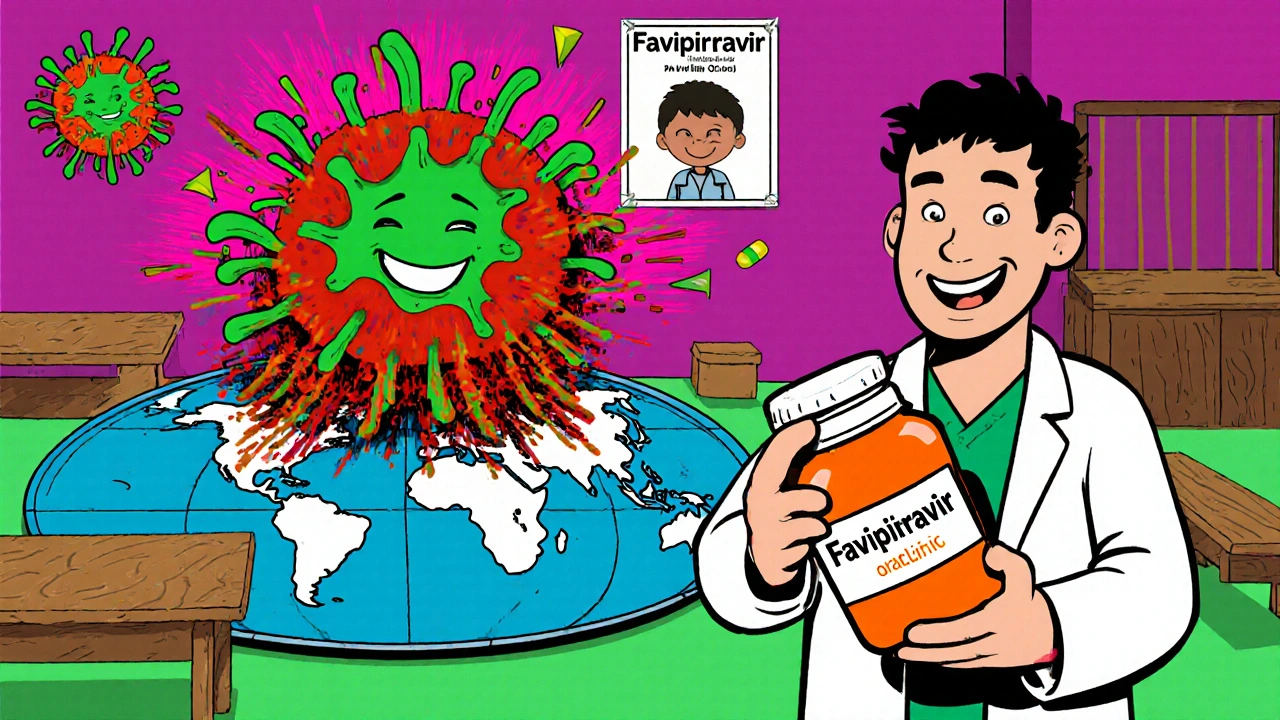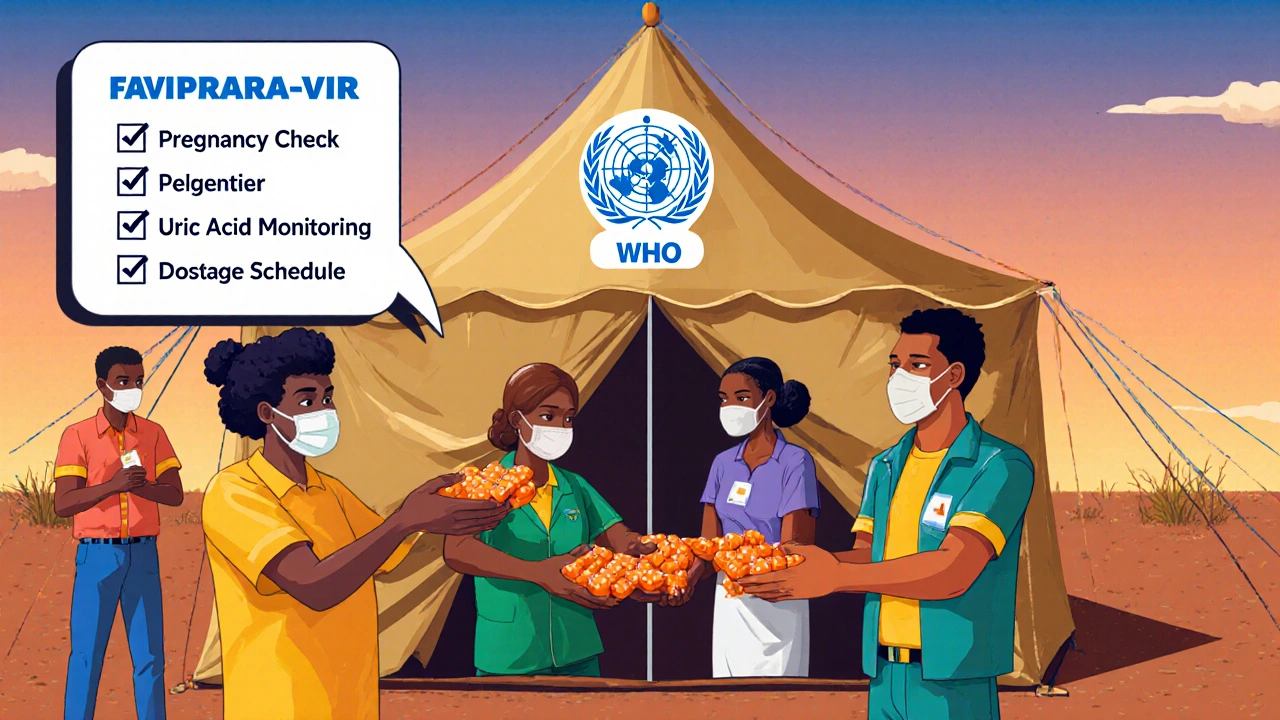 Oct, 25 2025
Oct, 25 2025
When a new virus pops up, the world scrambles for a drug that can keep up. Favipiravir has become that fast‑acting option for many outbreaks, and its story is worth a close look.
What is Favipiravir?
Favipiravir is a broad‑spectrum antiviral originally developed in Japan to treat influenza. It received its first approval in 2014 for resistant flu strains and has since been repurposed for a host of RNA viruses. The drug is taken orally, which makes it attractive for low‑resource settings where IV treatments are hard to deliver.
How It Works Against RNA Viruses
Favipiravir targets the RNA‑dependent RNA polymerase (RdRp), the enzyme viruses need to copy their genetic material. By mimicking a nucleotide, it slips into the growing RNA chain and causes lethal mutations-a process called “error catastrophe.” This mechanism is not virus‑specific, which explains why the drug shows activity against influenza, Ebola, COVID‑19, and even newer threats like Nipah.
Key Trials That Proved Its Punch
Several well‑designed studies have shaped the current confidence in Favipiravir:
- Influenza: A Phase III trial in Japan (n=442) demonstrated a 50 % faster viral clearance compared with oseltamivir.
- Ebola: The PALM‑E trial in West Africa (2022) used a 2400 mg loading dose followed by 1200 mg twice daily. Mortality dropped from 62 % (standard care) to 38 % (Favipiravir) among patients treated within 48 hours of symptom onset.
- COVID‑19: A multicenter Chinese study (n=150) showed reduced time to clinical improvement (median 7 vs 11 days) when treatment started early.
Across these investigations, the common thread is early administration-once the virus replicates vigorously, the error‑catastrophe effect is most potent.

Favipiravir vs Other Antivirals
| Attribute | Favipiravir | Remdesivir | Molnupiravir |
|---|---|---|---|
| Route | Oral | IV | Oral |
| Primary Target | RdRp (error catastrophe) | RdRp (chain termination) | RdRp (error catastrophe) |
| Approved Indications (2024) | Influenza (Japan), Clinical trial use for Ebola, COVID‑19 | COVID‑19 (hospitalized) | COVID‑19 (outpatient) |
| Typical Dosage | 1800 mg day 1, then 800 mg BID | 200 mg IV loading, then 100 mg daily | 800 mg BID for 5 days |
| Key Safety Concerns | Hyperuricemia, teratogenicity | Elevated liver enzymes | Potential mutagenicity (theoretical) |
The table shows why many low‑and‑middle‑income countries favor Favipiravir: it’s cheap, oral, and works against a wide range of RNA viruses.
Real‑World Use in Recent Outbreaks
Since 2020, several nations have added Favipiravir to their emergency stockpiles. Australia’s Therapeutic Goods Administration (TGA) issued a compassionate‑use protocol for severe COVID‑19 cases in 2023, allowing clinicians to prescribe the drug while data collection continued. In 2024, the World Health Organization (WHO) listed Favipiravir as a “recommended therapeutic option” for novel influenza strains that show resistance to neuraminidase inhibitors.
Case reports from Bangladesh illustrate the drug’s impact on a Nipah virus flare‑up. A small cohort (n=12) received a 2400 mg loading dose followed by 800 mg BID for ten days. Ten patients survived, compared with a 30 % mortality rate observed in historical controls.
Safety, Dosing and Challenges
While Favipiravir’s safety profile is generally favorable, a few cautions remain:
- Teratogenic risk: Animal studies show fetal malformations, so it’s contraindicated in pregnancy and requires reliable contraception for women of child‑bearing age.
- Hyperuricemia: Elevated uric acid can trigger gout attacks; clinicians should monitor serum levels during prolonged therapy.
- Drug interactions: Strong inducers of CYP2C8 (e.g., rifampicin) may lower plasma concentrations, reducing efficacy.
Dosing adjustments are needed for renal impairment-reduce the maintenance dose by 50 % when creatinine clearance falls below 30 mL/min.

Future Directions and What to Watch
Three research avenues could extend Favipiravir’s reach:
- Combination regimens: Early data suggest that pairing Favipiravir with monoclonal antibodies or interferon‑beta enhances viral clearance without adding safety signals.
- Prophylactic use: A Phase II trial in healthcare workers exposed to Lassa fever is testing a low‑dose pre‑exposure schedule.
- Formulation improvements: Researchers at the University of Queensland are exploring a fast‑dissolving tablet that could be administered without water-useful in field settings.
Keep an eye on the upcoming WHO guideline revision (expected Q2 2025) that may elevate Favipiravir to a first‑line option for any novel RNA virus with limited treatment alternatives.
Quick Checklist for Clinicians
- Confirm pregnancy status and ensure contraception if applicable.
- Order baseline uric acid, liver function and renal panels.
- Start with 1800 mg twice on day 1, then 800 mg twice daily for 4-10 days, depending on severity.
- Monitor for gout flares; treat with allopurinol if needed.
- Document adverse events and share data with national pharmacovigilance programs.
Frequently Asked Questions
Can Favipiravir be used for mild COVID‑19 at home?
Yes, many countries have approved an outpatient regimen (800 mg twice daily for five days) for patients without risk factors. Early treatment is key to reducing viral load.
How does Favipiravir differ from Remdesivir?
Remdesivir is given intravenously and works by terminating RNA synthesis, while Favipiravir is oral and induces lethal mutagenesis. The oral route makes Favipiravir easier to deploy in outbreaks.
Is there a risk of the virus becoming resistant?
Because Favipiravir forces the virus to accumulate many mutations, the chance of a single resistance mutation is low. However, sub‑therapeutic dosing could theoretically select for tolerant strains, so adherence matters.
What monitoring is recommended during therapy?
Baseline and weekly checks of uric acid, liver enzymes (ALT/AST), and renal function are advised, especially for treatment longer than seven days.
Can Favipiravir be combined with other antivirals?
Early studies suggest synergistic effects with monoclonal antibodies and interferon‑beta, but clinicians should follow local protocols and watch for additive toxicities.

Clinton Papenfus
October 25, 2025 AT 13:09Favipiravir represents a noteworthy advancement in antiviral therapeutics. Its oral formulation facilitates deployment in resource‑limited settings.
Zaria Williams
October 26, 2025 AT 16:56When you check the dosing schedule you’ll notice the loading dose is massive – 1800 mg twice on day one – and that’s by design to hit the virus hard fast. The early start window is key; most trials show a clear win when treatment begins within 48 hours of symptom onset. Yeah the side‑effects like gout can be a pain but for many out‑breaks that risk is worth the trade‑off. Some folks think the oral route is a gimmick but in low‑resource zones it’s lifesaving – no IV lines, no fancy equipment. The data from the PALM‑E Ebola trial still blows my mind because mortality dropped dramatically.
ram kumar
October 27, 2025 AT 20:43Alas, the prose extolling Favipiravir’s virtues drifts into the realm of naïve optimism, glossing over the stark realities that haunt the afflicted. The drug, while undeniably potent, is shackled by a specter of hyperuricemia that can erupt into gouty torment, a burden few authors dare to spotlight. Moreover, the teratogenic shadow that looms over women of child‑bearing age is not a trivial footnote but a clarion call for stringent safeguards. One must also reckon with the economic paradox: a cheap pill on paper, yet the logistical labyrinth of loading doses and prolonged monitoring inflates the hidden cost. The clinical trials cited, though impressive in headline numbers, often suffer from selection bias, enrolling patients who present early and thus skewing outcomes. In the Ebola saga, the mortality plunge was as much a function of early intervention as of the drug itself, a nuance lost in celebratory summaries. The mechanism of “error catastrophe” sounds poetic, yet viruses are masterful architects of mutational escape, and the long‑term evolutionary pressure remains an open question. When the authors parade tables of comparative safety, they omit the subtle hepatic perturbations that some patients endure under the radar. The enthusiasm for oral administration, while laudable, may mask the reality that adherence in chaotic outbreak settings is far from guaranteed. One cannot ignore the ethical quagmire of deploying an agent with known teratogenic potential in regions lacking robust contraception infrastructure. The authors’ optimism, though well‑intentioned, borders on hubris, presenting Favipiravir as a panacea rather than a tool with clearly defined limits. The selective citation of positive outcomes without acknowledging dissenting data creates a narrative bias that misguides clinicians. Even the promising combination regimens are nascent, their synergistic claims built on modest sample sizes and preliminary endpoints. The forthcoming WHO guideline may elevate the drug’s status, yet history teaches us that guidelines are as much a product of politics as of evidence. In sum, the drug’s promise is real, but its deployment must be tempered with humility, vigilance, and a sober appraisal of the data.
Melanie Vargas
October 29, 2025 AT 00:29Thank you for laying out the complexities so clearly 😊. It’s crucial that we balance hope with caution, especially when caring for vulnerable communities.
Buddy Bryan
October 30, 2025 AT 04:16Let’s cut to the chase – clinicians need a concrete monitoring plan. Baseline uric acid, liver enzymes, and renal function before starting Favipiravir, then repeat every 48 hours for a week. If uric acid spikes, intervene early with allopurinol to avoid gout attacks. Pregnant patients are absolutely contraindicated; enforce strict contraception documentation. For patients with CrCl < 30 mL/min, slash the maintenance dose by half and watch the trough levels. Adherence is non‑negotiable – incomplete courses breed sub‑therapeutic exposure and risk resistance. Document every adverse event and feed the data back to national pharmacovigilance; the more we know, the better we can refine dosing.
Jonah O
October 31, 2025 AT 08:03Yo, I tripped over the usual pharma narrative – they don't want us to see the real agenda. The big pharma lobbies the WHO to push Favipiravir as a cash‑cow while hiding long‑term mutagenic risks. Check the hidden data leaks, they show patterns of suppressed side‑effects. It's not a coincidence that the drug got fast‑track approval right after the pandemic panic.
Aaron Kuan
November 1, 2025 AT 11:49Favipiravir: a bright bullet against mutating microbes.
Brett Witcher
November 2, 2025 AT 15:36While the aphoristic brevity is appreciated, a rigorous appraisal would note that the pharmacokinetic profile of Favipiravir necessitates a loading dose to achieve steady‑state concentrations, a nuance absent from the terse statement.
Benjamin Sequeira benavente
November 3, 2025 AT 19:23Team, let’s rally behind the evidence and push for wider access to Favipiravir where it matters most! Deploy the oral kits, train the frontline workers, and monitor outcomes relentlessly – the world needs this tool now.